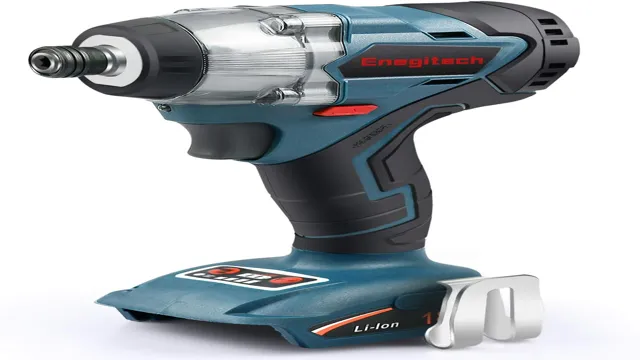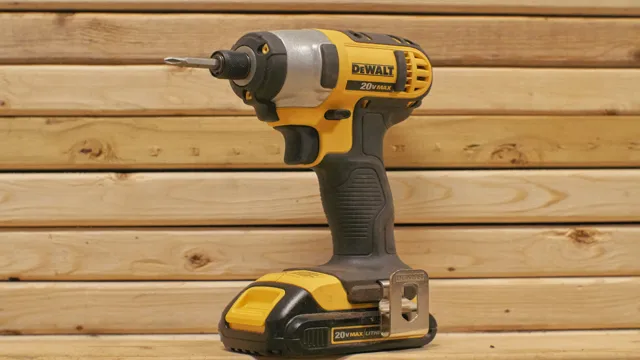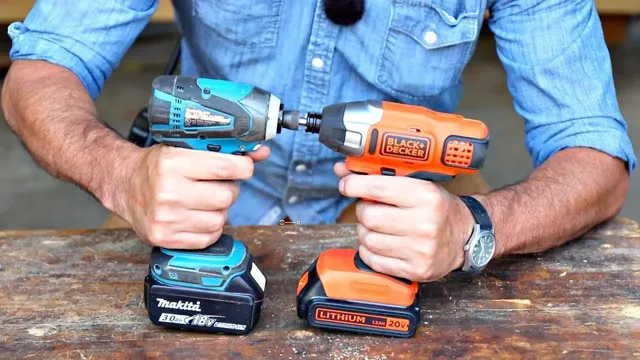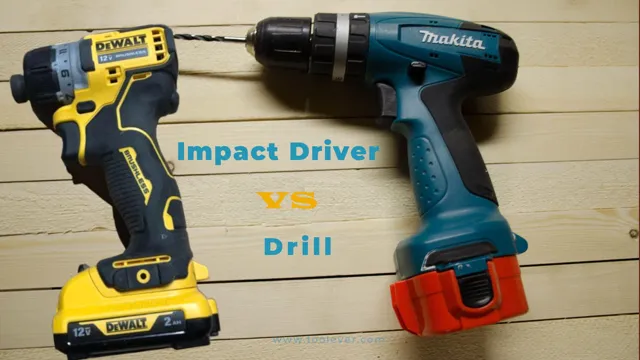What Bits Do You Use with an Impact Driver? A Beginner’s Guide
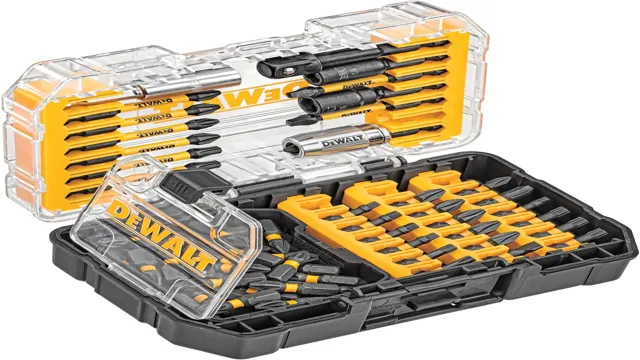
Impact drivers are a must-have tool for every DIY enthusiast and professional alike, especially when it comes to driving long screws into different materials. They work by delivering sudden, high-torque bursts of power that allow you to sink screws without any effort. Whether you’re a seasoned pro or a novice DIYer, using an impact driver can help you save time and gain better results.
Unlike traditional drills, that rely on constant force, impact drivers concentrate force in short bursts, reducing the chances of stripping or damaging screw heads. They also generate higher torque levels, which means they are ideal for use with tougher materials such as hardwoods, metals, and dense, composite materials. If you want to take your DIY projects to the next level and achieve professional-looking results without breaking the bank, investing in an impact driver is a smart move.
Not only will it make your work faster, but it will also increase the quality of your work, and ensure that your screws are optimally secured. In this blog, we’ll take a closer look at how to use impact drivers and share some useful tips to make your projects smoother and more efficient.
Understanding Bits
When it comes to impact drivers, the type of bits you use is crucial in achieving efficient and effective results. The most commonly used bits for impact drivers are hex shank bits. These bits have a hexagonal shape that fits snugly into the chuck of an impact driver, ensuring a secure grip.
Additionally, they are readily available and come in a variety of sizes and types. Other types of bits that can be used with an impact driver include Phillips, slotted, Torx, and square bits, among others. It is important to select the right bit for the job to ensure maximum power transfer and minimize damage to the tools.
When selecting a bit for your impact driver, consider the material you will be working with, as well as the type and size of the screw you will be driving. Choosing the right bit will save you time and effort, and ultimately lead to better results.
What are Impact Driver Bits?
Impact driver bits are specialized tools used to insert screws into various materials such as wood, metal, and plastic. These bits are designed to fit perfectly into the chuck of the impact driver and deliver exceptional strength and torque for maximum efficiency. You can choose from a wide array of shapes, sizes, and materials depending on the type of screw you are using and the task at hand.
Some of the most popular materials for impact driver bits are titanium, cobalt, and high-speed steel. These materials are extremely durable and can handle high levels of stress without breaking or stripping. Overall, understanding the different types of impact driver bits is crucial for getting the job done right and achieving professional-quality results.
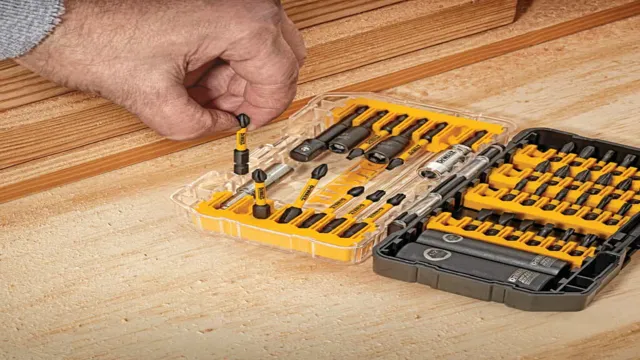
Types of Impact Driver Bits
Understanding the different types of impact driver bits can be confusing, but it’s essential if you want to get the most out of your tool. Impact driver bits come in various sizes and shapes, each designed for specific tasks. The most common types of bits include Phillips, Torx, and Hex.
Phillips bits are the most widespread type and are ideal for driving screws into wood and other soft materials. Torx bits are excellent for precision work and are often used in the automotive industry. Hex bits are used in construction and woodworking and are typically used for driving large screws and bolts.
It’s important to choose the right bit for your job to ensure a smooth and efficient process. Knowing what type of bit you need and making sure you have it on hand can save you time and money in the long run. So, take the time to understand the different types of impact driver bits, and you’ll be able to tackle any job with confidence.
Choosing the Right Bit for the Job
Choosing the right bit for the job can make all the difference in your woodworking project. Understanding bits can be a bit overwhelming, but essentially, a bit is a cutting tool that is attached to a drill or router. Bits come in different shapes, sizes, and materials, and each is designed for a specific task.
For example, a straight bit is ideal for cutting a groove or dado, and a round-over bit is used to create a curved edge on a piece of wood. It’s essential to consider the material you’ll be cutting and the type of cut you’ll be making when selecting a bit. Harder materials like metal or stone require tougher bits made of materials like carbide or diamond.
Keeping these factors in mind ensures that you pick the right bit for the job, resulting in a beautiful and accurate finished product.
Factors to Consider
When it comes to using an impact driver, it’s important to consider what bits to use for optimal performance. Choosing the right bit can make all the difference. One of the factors to consider is the type of material you’ll be driving screws into.
For example, if you’re working with wood, you’ll want to use a standard wood screw bit, while a concrete screw bit would be necessary for driving screws into masonry. Another factor to consider is the size of the screw. Using a bit that’s too small can result in stripped screws, while using one that’s too large can damage your materials.
An impact driver is a powerful tool, so it’s crucial to choose a bit that is strong enough to handle the torque. Ultimately, the key is to select the right bit for the specific job you’re doing, keeping in mind the material, screw size, and required torque. By doing so, you can ensure optimal performance and a smooth, reliable outcome every time.
Material of the Bit
When it comes to choosing the right bit for your horse, the material it’s made of is an important factor to consider. There are several materials commonly used for bits, each with their own unique features and benefits. One of the most common materials is stainless steel, which is durable and easy to clean.
Copper is another popular option, as it’s known to promote salivation and encourage a softer, more responsive mouth. Some riders prefer bits made from rubber or plastic, as they tend to be softer and more flexible than metal bits. Ultimately, the material you choose will depend on your horse’s individual needs and preferences, as well as your own personal preferences as a rider.
When selecting a bit, it’s important to consider factors such as the horse’s age, level of training, and sensitivity. Keep in mind that different materials may also affect the fit and comfort of the bit in your horse’s mouth, so be sure to work with a knowledgeable trainer or equine professional to ensure that you make the right choice.
Type of Screw
When it comes to selecting the right screws for your DIY project, it’s important to consider the type of screw that you need. There are various types of screws that are available in the market, and each one is designed to serve a particular purpose. The factors that you should consider when selecting the right type of screw include the material that you are screwing into, the load-bearing capacity of the screw, the size and length of the screw, and the type of screwhead.
If you are screwing into softwood, you’ll need a screw with a coarse thread. On the other hand, if you are screwing into hardwood, you’ll need a screw with a fine thread. You should also consider the load-bearing capacity of the screw.
If you are fixing something heavy onto the wall, you should use screws with a larger diameter and longer length. You should also consider the type of screwhead. There are a variety of screwheads available, including Phillips, flathead, and hex.
The Phillips screwhead is the most common one, and it’s easy to use with a screwdriver. The flathead screwhead is useful when you need to countersink the screwhead, while the hex screwhead gives you more torque and is useful for heavy-duty applications. In conclusion, selecting the right type of screw is important for the success of your DIY project.
By considering the factors mentioned above, you’ll be able to choose the right screw that will work best for your project. Whether you are screwing into softwood or hardwood, fixing something heavy onto the wall, or need a screwhead with more torque, there’s a screw out there that is perfect for the job. So take some time to choose the right screw, and you’ll be able to complete your project with ease and confidence.
Size of the Bit
When it comes to the size of the bit, there are several factors to consider. One of the most important factors is the type of project you’ll be working on. For instance, if you’re working on a large construction project, you’ll need larger sized bits to get the job done efficiently.
Another important factor to consider is the type of material you’ll be drilling into. Some materials, like concrete, require larger and tougher bits to get through. It’s also worth noting that the size of the bit can affect the overall speed and precision of your work.
Using the wrong size can result in sloppy work and wasted time. So, it’s crucial to take the time to determine the appropriate size based on your project and desired outcome. Ultimately, when it comes to the size of the bit, it’s all about finding the right balance between efficiency and precision.
Conclusion
In the world of impact drivers, the bits you choose are just as important as the tool itself. From hex shank bits to socket adapters, the possibilities are endless. So, whether you’re driving screws, drilling holes, or tightening bolts, always remember to choose the right bit for the job.
After all, the impact driver may be the superhero, but the bits are its trusty sidekicks – ready to take on any challenge with style and precision.”
FAQs
What is an impact driver and how does it work?
An impact driver is a power tool that delivers strong, sudden rotational and downward force, often used to loosen screws. It works by compressing a spring and then releasing it, resulting in a sudden rotation that generates high torque.
Can impact drivers be used for drilling?
Yes, impact drivers can be used for some types of drilling, such as drilling in wood or thin metal. However, they are not as precise as regular drills and should not be used for drilling very small holes or in delicate materials.
What are the advantages of using an impact driver over a regular drill?
Impact drivers are typically more powerful and can deliver higher torque than regular drills, making them better suited for heavy-duty tasks such as driving long screws or working with dense materials like hardwood. They are also more compact and lightweight than drills, making them easier to maneuver in tight spaces.
What kind of bits can be used with an impact driver?
Impact drivers can use standard 1/4 inch hexagonal bits, including various types of screwdriver bits and some types of drill bits. However, it is important to select bits that are specifically designed for use with impact drivers, as standard bits may be damaged or break under the high torque of an impact driver.
Are impact drivers suitable for delicate or precision work?
No, impact drivers are not well-suited for delicate or precision work, as they are designed for high-torque tasks and can be difficult to control at low speeds. For such tasks, a regular drill or a specialized precision tool may be more appropriate.
What safety measures should be taken when using an impact driver?
Users of impact drivers should wear eye and ear protection, as well as gloves to protect against hand injuries. It is also important to secure materials properly before using the driver, and to avoid placing body parts near the working end of the tool. Additionally, users should ensure that the driver is powered off and unplugged before changing or adjusting bits.
Can impact drivers be used for automotive work?
Yes, impact drivers are often used in automotive work, particularly for loosening tight bolts and screws. However, it is important to select the appropriate bit and setting for the task, and to use caution when working with delicate or fragile parts.

